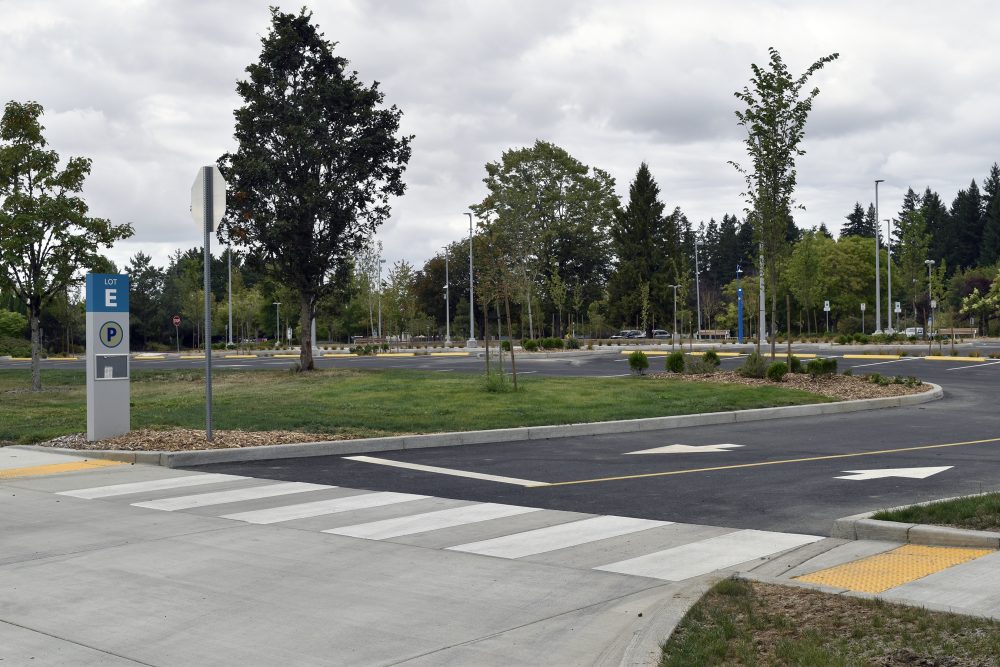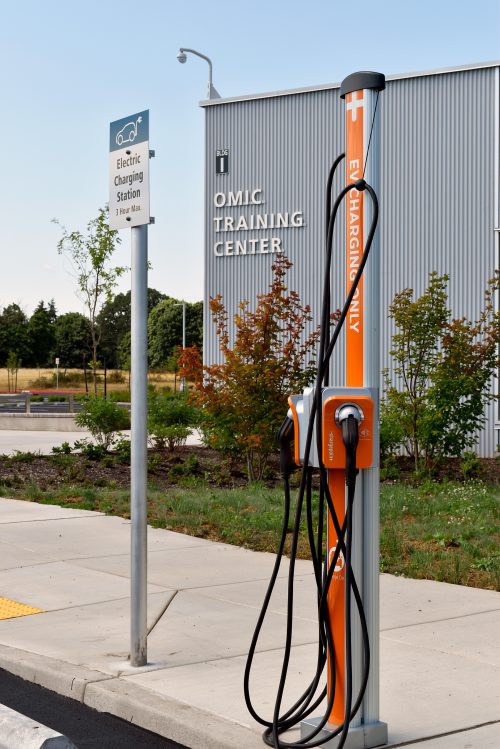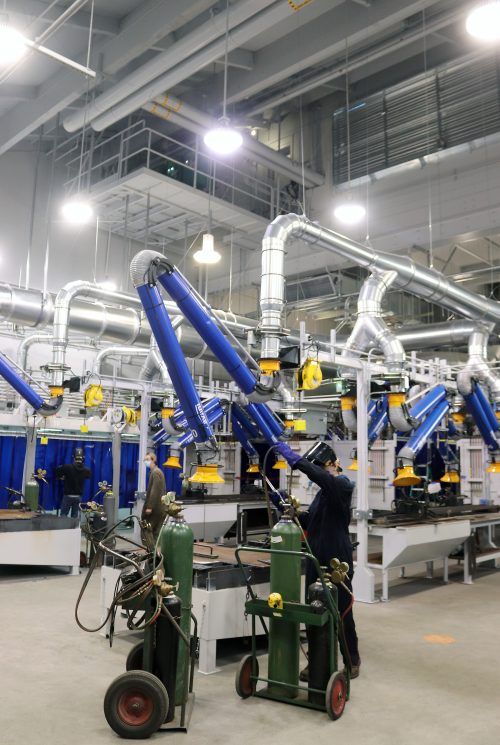This content was published: September 30, 2021. Phone numbers, email addresses, and other information may have changed.
Bond improvements help drive PCC’s significant sustainability achievements
Story by Katherine Miller. Photos by James Hill & Wendy Wright.

Sustainability was centered in the improvements to the Event Center Parking Lot at Rock Creek Campus.
Sustainability is an important part of Portland Community College’s mission, making it one of the top-ranked community colleges to be recognized in the Association for the Advancement of Sustainability in Higher Education (AASHE)’s Sustainable Campus Index.
New energy-efficient buildings funded by the 2008 and 2017 voter-approved bond measures, as well as additions such as solar panels, electric vehicle charging stations, recycling bins and water bottle refilling stations are readily apparent.
But as valuable as those additions are, it’s the less-visible capital improvements at PCC’s many facilities that have had the biggest impact on reducing the greenhouse gases that affect climate change. Sustainability Manager Briar Schoon said that since 2006, the college has achieved a 45% decrease in energy use per square foot. This accomplishment helped PCC earn its third silver rating from AASHE’s Sustainability Tracking, Assessment & Rating System (STARS) in March of 2021.
“We’ve made significant progress towards our 2021 Climate Action Plan, which establishes a new carbon neutrality goal of 2040,” Schoon said. “Our achievements have resulted in big greenhouse gas savings: a 51% reduction in our Scope 1 and 2 emissions. The built environment has a big impact on our carbon footprint, and much of these savings can be attributed to a focus on sustainability and energy conservation in our bond improvements.”
According to the Carbon Trust, Scope 1 covers direct emissions from owned or controlled sources. Scope 2 covers indirect emissions from the generation of purchased electricity, steam, heating and cooling consumed by the reporting company. Scope 3 includes all other indirect emissions by activities like commuting, business travel and waste disposal.
Laura Ward, mechanical project manager consultant to PCC, explained that PCC’s operational carbon footprint is largely measured by calculating Scope 1 and 2 emissions.
“While the college has grown in square footage, we’re using the same amount of electricity,” she added. “Also, our natural gas consumption has dropped by 54% since 2006, which is due in part to capital improvements such as the new central boiler plant at the Rock Creek Campus.”
PCC has also been consistently recognized for its work in measuring Scope 3 emissions.
One of the many projects with significant energy-efficient features is the construction of the Oregon Manufacturing Innovation Training Center in Columbia County. Known as the OMIC Training Center, this new facility received LEED silver certification and was designed to achieve approximately 22% energy savings over baseline. The project also included the use of low-carbon materials, the diversion of construction waste from the land-fill and the installation of water-efficient fixtures.
At the Rock Creek Campus, the college recently completed the $6 million remodel of the shop for the Welding Technology Program. The 50-year-old shop was modernized into a state-of-the-art, 10,000-square-foot facility with new welding booths and new energy-efficient mechanical and electrical systems. And, the campus’ Parking Lot E project offered opportunities for sustainability improvements, said Ed Herrera, senior architect and senior associate with BRIC Architecture.
“At the beginning of our design discussions it was evident that we needed to protect the existing oak trees for Landscape Technology’s curriculum as we tried to maximize the parking space quantities,” he said. “We also integrated a portion of the proposed landscape design for the students to finish planting as part of their learning process. Those, along with the stream spray irrigation system we designed, have allowed us to approach this project as a sustainable outdoor learning environment for the campus.”
At the Portland Metropolitan Workforce Training Center in North Portland, the college is building its first project with cross laminated timber (CLT), a type of “mass timber” that creates large panels and beams by gluing smaller boards of wood together and alternating the direction of their grain so that the end product is stronger than standard wood construction. CLT has many environmental benefits, starting with the fact that trees are a sustainable resource, and trees and their lumber sequester carbon their entire lives while concrete releases carbon.
PCC hired Bartlett Tree Experts to conduct a survey of the trees at every location. The survey established the identity, location, condition and monetary value of many of the trees and provided data that will contribute to academic programs and inform the tree conservation efforts that are being integrated with PCC’s Climate Action Plan. PCC is a member of Tree Campus USA, a national program created by the Arbor Day Foundation to recognize colleges and universities for effective campus forest management and help them grow their community’s forests.
These and many other energy efficiency-related projects are not only reducing greenhouse gases and utility costs, they are also extending the life of buildings and improving their utility, said Krista Phillips, who serves as the Planning & Capital Construction Office’s managing architect.
“Having sustainability goals as a guiding principle for deferred maintenance projects, remodels, and new construction enables PCC to offer healthy, safe built environments to our students and staff,” she said. “These improvements impact the college operations and the communities we serve, in alignment with PCC’s goals for equity and sustainability.”


